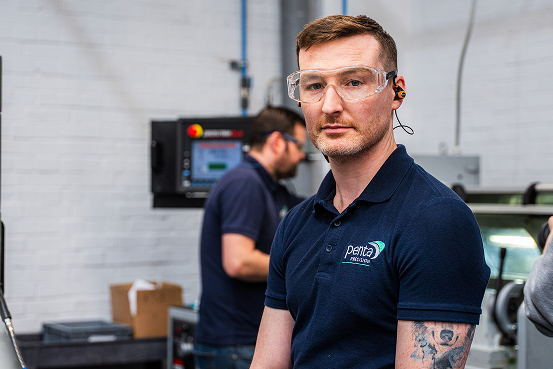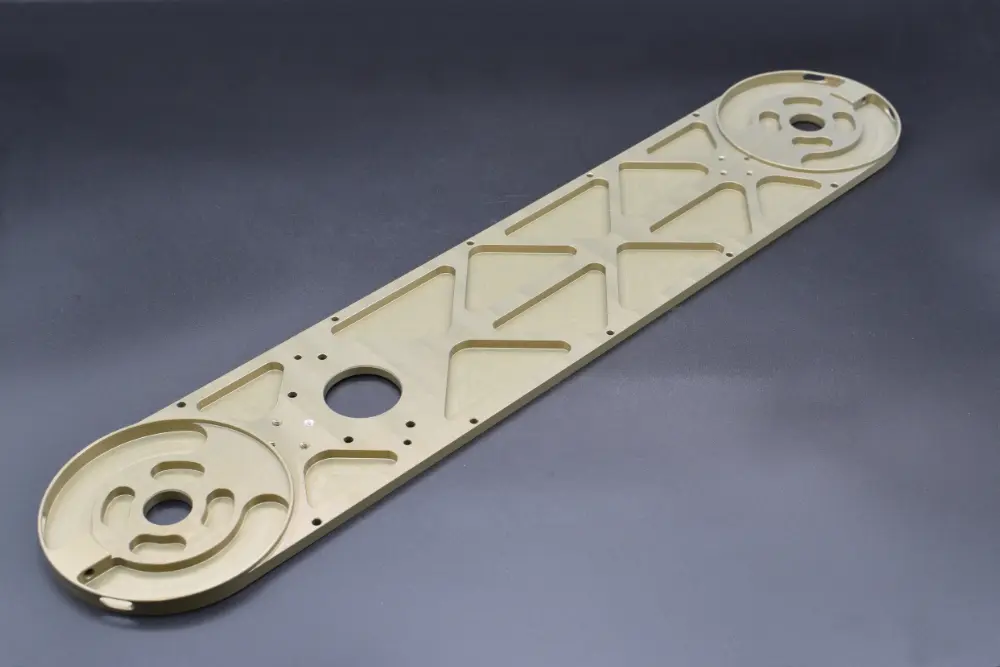 Get a quote
Get a quoteAs well as our own machining expertise, we are able to access our network of approved quality suppliers for the finishing of your parts, saving you the time and effort and helping to streamline your supply chain.
Customers turn to us when they have had quality and delivery issues with their existing suppliers and need a reliable machining partner.
As aluminium “oxidises” (the natural reaction between air and aluminium) it produces a loose dry white powder, aluminium oxide.
Chromic acid anodising is an electrolytic process using electricity (DC current) and a chromic acid electrolytic solution causing oxidation of the aluminium surface to form a thin dense flexible grey “harder” film of aluminium oxide under controlled conditions.
The passing of the current liberates high volumes of oxygen at the surface of the aluminium, thus aiding controlled formation of the oxide layer.
These processes do not produce a coating but are a conversion of the surface aluminium to aluminium oxide and are therefore metallurgically bonded.
This method produces a comparatively thin, flexible but dense oxide film which is usually dark grey in colour.
It has very good corrosion resistance but isn't really suited to subsequent dyeing.
Because the film is thin, it doesn't affect close tolerances and is therefore used extensively in the aerospace and defence industries.
If left unsealed it is an excellent base for subsequent painting operations as the first coat of paint soaks in to the pores.
Chromic acid anodising is ideal for structurally important components as is often the case in aerospace and defence applications.
The thin film reduces the possibility of fatigue fracture on the component and unlike sulphuric acid, chromic acid protects rather than attacks aluminium; any residual solution that may have been trapped in cracks, pores or folds will not corrode.
In addition, the process also acts as a non-destructive, flaw-detection test due to the brown/orange colour of the chromic solution and the fact that it is extremely searching and will thus seep in to even the smallest of flaws; thus a stain will become apparent around the flaw.
This test is used commonly on defence related products.
Please note: As a result of the utilisation of hexavalent chromium, there is a gradual discontinuation of chromic acid anodising wherever feasible. Globally, laws and regulations are being implemented to restrict its usage, and in certain instances, it is banned outright. If you are in the process of designing a new product or updating an existing one, you might want to explore the option of using sulphuric acid anodising instead. Our technical team is available to support you in making informed decisions, so feel free to contact us for assistance.
Chromic acid anodising is not suitable for:
The coating is on metal less than 5 microns thick, the process and resultant coating have less adverse effect upon the properties of the underlying metal.
Although the process is controlled anodising needs to be regarded as an “artisan” process and not a high precision process.
Due to the use of hexavalent chromium, chromic acid anodising is gradually being phased out wherever possible. Laws and regulations are being enacted around the world both restricting its use and in some cases banning it outright. If you are designing a new product or updating an existing one, you may wish to consider using sulphuric acid anodising, there has been developments with mixing sulphuric acid and either Tartaric acid or Boric acid as a method of replacing the less environmentally acceptable chromic acid solution.
Chromic acid anodising works best on aluminium grades with few alloying elements:
Deep etch to “matt” down the “satin sheen” appearance.
Bead blast or “brush finish” to give a uniform texture”. This “dull” the surface. A chemical “Brightening” process is used to bring the surface “sheen” back.
“Natural” chromic anodise results in grey tints.
Black chromic anodise is a possible variant to ensure a consistent colour and tone.
Hot De-mineralised Water Seal is possible.
Chromic acid anodising may contain hexavalent chromium and we cannot guarantee how much it will contain, so we do not claim RoHS compliance.
Chromic acid anodising can be sealed or left in the unsealed condition. It is generally left unsealed for customers who plan to paint it.
Air is vigorously pumped to agitate the chemical fluid through the anodising process, deep recesses, blind bores and holes can lead to air pockets being formed with resulting poor or inconsistent anodise layers being formed.
Whenever a consistent high quality level of finish is required, best practice is to discuss the processing issues of individual components with us and on manufacturing drawings specify jigging and fixturing points and the orientation of the part when in the process.
If the item to be anodised contains crevices or small blind holes from which it may be difficult to remove electrolyte; traces of the highly coloured chromic acid are easily seen but, in any case, are non-corrosive towards aluminium. In fact this ability is exploited in the field of crack detection where the presence of chromic acid leaching out of a crack is easy to detect.
Anodising is an “artisan” not a precision process. Although competent processors run a defined controlled process, factors that affect the results in the anodising process:











Delve into the essentials of surface finishing and explore the five key factors every specifier and engineer should consider when deciding on the appropriate surface finish for their CNC machined part.

Among the various types of anodising processes, two prominent methods stand out: Hard Anodising and Sulphuric Acid Anodising. In this blog, we delve into the distinctions of each of these finishing processes, comparing their benefits, common applications, and suitability for CNC machined components.